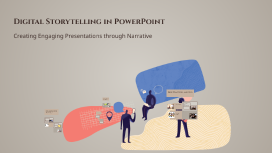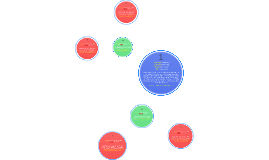Digital Storytelling in PowerPoint
Transcript: Digital Storytelling in PowerPoint Creating Engaging Presentations through Narrative Best Practices and Tips Designing Your Digital Story Choosing a Central Theme Structuring the Narrative Selecting a central theme provides the foundation for your digital story, ensuring clarity and focus throughout the presentation. A well-defined theme resonates with your audience and shapes the narrative, making it more memorable and engaging. A structured narrative guides the audience through the story, establishing a clear beginning, middle, and end. This flow not only keeps the audience engaged but also enhances information retention and comprehension, creating a more impactful experience. Rehearsing Your Presentation Keeping It Simple and Concise Utilizing Multimedia Tools Selecting Visual Elements Multimedia tools, such as videos, sound effects, and animations, enrich the storytelling experience. By incorporating diverse media, presentations become more dynamic and engaging, appealing to different learning styles and preferences. Visual elements, including images, graphics, and color schemes, complement the narrative and evoke emotions. By carefully selecting visuals that align with the story, presenters can enhance understanding and create a lasting impact. Simplicity enhances understanding; eliminate unnecessary details to focus on core messages. Use clear visuals and direct language to ensure the audience retains key information without overwhelming them. Rehearsal aids in delivery and timing, leading to a confident presentation. Practicing in front of a live audience helps identify areas needing improvement while enhancing overall performance. Engaging Your Audience Continuous Improvement and Learning Introduction to Digital Storytelling Gathering Feedback Definition of Digital Storytelling Engagement in ongoing learning is essential for growth as a presenter. Analyze feedback, observe other presentations, and stay updated with trends to refine skills and techniques continuously. Digital storytelling is the practice of using digital tools to tell stories, often incorporating images, video, audio, and text. This approach enhances the storytelling experience and allows for creativity in how narratives are presented. Soliciting feedback post-presentation provides insights into audience perceptions. Use surveys or informal discussions to gauge effectiveness, which informs future improvements and refinements. Importance in Presentations In presentations, digital storytelling captivates audiences by making information relatable and memorable. The use of narrative can increase audience engagement, retention rates, and overall effectiveness of the message. Identifying Your Audience Components of a Digital Story A successful digital story typically includes elements such as a clear narrative arc, character development, emotional appeal, and the integration of multimedia elements. These components come together to create a cohesive and impactful experience. Knowing your audience influences the design of your message. Conduct audience analysis to tailor content, ensuring it resonates with their interests, knowledge levels, and expectations, leading to effective communication. Benefits of Using Storytelling in Presentations Storytelling in presentations offers multiple benefits, such as enhancing audience connection, conveying complex messages simply, and improving memorability. This technique fosters a deeper understanding and emotional response to the content presented. Incorporating Interactive Elements Techniques for Engagement Engagement techniques such as storytelling, humor, and rhetorical questions capture audience attention. These methods create a connection that enhances retention and encourages active participation in discussions. Interactive elements like polls, quizzes, or Q&A sessions actively involve the audience. These strategies provide real-time feedback and create a dynamic environment that stimulates engagement and discussion. Using Transitions and Animations Effectively Well-timed transitions and animations maintain audience interest by highlighting key points. Overuse can be distracting, so balance is important to retain focus while enhancing narrative flow.

















